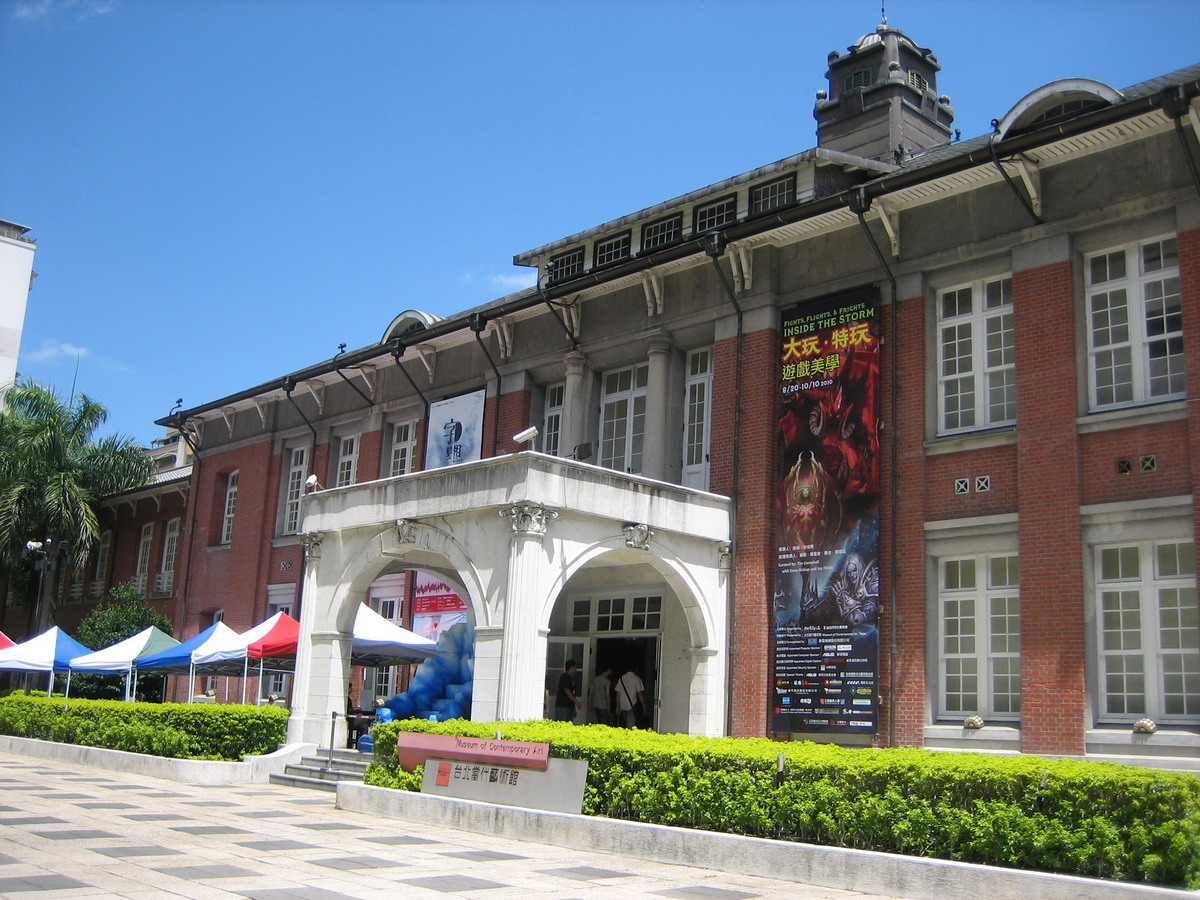台北當代藝術館的館舍建築,落成於西元1921年,原為日治時期專供日本人子弟受教育的「建成小學校」。主建築為面寬120公尺的兩層樓房,以亞熱帶文化的紅磚壁構與木材屋架,結合西方文明的建築柱式與黑瓦斜屋頂,加上兩側入口為山牆形式的廂廊,整體結構為U字型的建築空間。1945年後,台灣進入中華民國時代,原建成小學校舍被轉用為台北市政府辦公廳舍,直至1994年台北市政府遷入信義區的新市政中心為止。在這五十年當中,這棟建築物扮演了驅動台北市政建設的一個神經中樞角色。
The Museum of Contemporary Art Taipei is the first art institution in Taiwan dedicated exclusively to contemporary art. The museum building was originally the Jan Cheng Elementary School, established during the Japanese colonial period. In 1945, the building became the Taipei Government City Hall. After the government moved to Hsinyi District in 1994, the policy of the reuse of historical buildings prompted the old city hall to be transformed in May 2001 into the Museum of Contemporary Art Taipei and Jan Cheng Junior High School. MOCA Taipei is the first museum in Taiwan to be successfully built in a historical building, and it is the only one of its kind to share the same architecture with a school.
1996年,台北市政府舊廈被指定為市定古蹟,並基於古蹟再利用的政策,將原建物之正面廳舍修復整建為「台北當代藝術館」專用,兩翼部分建築則劃歸為建成國中教室。「台北當代藝術館」與「建成國中」新校的結合,不僅創造了全世界罕見美術館與學校使用共同建物的先例,也被視為是台北市孔廟到保安宮這一條歷史文化軸線的延展,而當代藝術館也象徵了帶動大同區再發展的一個新契機。從市定古蹟的台北舊市府,經活化再利用後而成立的台北當代藝術館,在國內藝術界殷殷關注之下,於2001年5月26日璀璨開幕,就此成為台北人文地圖上的新地標。台北市這幾年來積極活絡市內古蹟,或讓閒置空間以新的機能和風貌融入市民生活,進而帶動街區與社區再造,台北當代藝術館是第一個成功的案例。
台北當代藝術館自2001年開館後,前七年由市政府委託民間企業家組成的「當代藝術基金會」統籌營運,基金會董事和歷任館長、館員們悉心致力結合藝術古蹟和科技,陸續辦理了許多精采絕倫的當代藝術展覽,除了推動台灣與國際藝壇的對話,也大幅開拓了民眾的美感品味和文化視野。2008年1月1日起,為期七年的「公辦民營」合約結束,台北當代藝術館轉由台北市文化基金會接替營運。新的經營團隊除了延續之前的營運理念和方向,也努力匯聚海內外的關注,結合官方有限資源與民間贊助力量,媒合多元文化和跨界創意。除了扮演國際當代藝術展覽的重要據點,和彰顯台灣當代藝術成果的焦點櫥窗,當代館始終自我期許的三個目標,一是推動多元風貌的藝術創作與展覽,二是著眼於激發民眾的新觀點和新思維,三是提供當代城市發展源源不絕的創意與活力。
Since its inauguration, the museum has combined its historical architecture with contemporary art, entwining yesterday’s memories with today’s culture and introducing the most innovative and avant-garde visual aesthetics, media technologies, architectural design, and fashion from Taiwan and overseas. At the same time, MOCA Taipei continuously promotes artistic education and encourages the community to regard the aesthetics of everyday life. In the future, MOCA Taipei will persevere on its mission to promote and motivate multidisciplinary creativity both locally and internationally. With rich and diverse artistic performances, the museum will vigorously introduce creativity into Taipei, art into the community, and the ever evolving exhibition technology into the new life of the historical building.
在這個資訊透通,有形無形的各種關係網路正不斷形成,雙向互動的需求和技術也正式浮上檯面的web 2.0時代,當代藝術導向的專業美術館,除了需要掌握時代的趨向跟上全球的腳步,也需要在創作生產的這一端和藝術欣賞的另一端之間,鋪設更多的通道和橋梁,規劃各種有利於活絡藝術靈光、訊息傳播、教育學習、休閒娛樂、社區認同、文化建構…的整合機制。正如當代藝術本身是個現代進行式一般,我們希望這個整合機制本身保有一種「茍日新、日日新、又日新」的有機性格,不但能隨時自我補充加強,也能夠海納眾聲,追求更多的可能,共創台灣藝術文化的無限美景。
In the age of web 2.0, for a professional art museum that focuses on contemporary art, it has not only to keep up with the global trend, but also to bridge the industry itself with art appreciation. A system for the integration of artistic creation, information transmission, education, learning, entertainment, community recognition, and cultural construction must then be worked out. This integrated system should remain the spirit of contemporary art itself-- keep moving on actively and lively day by day. Determined to support such system, MOCA will strengthen its own ability to pursue more possibilities and broaden its own capacity to accept different opinions. Working together with other museums and artists, the prospects of art in Taiwan is immense and without limits. www.mocataipei.org.tw
The Museum of Contemporary Art Taipei is the first art institution in Taiwan dedicated exclusively to contemporary art. The museum building was originally the Jan Cheng Elementary School, established during the Japanese colonial period. In 1945, the building became the Taipei Government City Hall. After the government moved to Hsinyi District in 1994, the policy of the reuse of historical buildings prompted the old city hall to be transformed in May 2001 into the Museum of Contemporary Art Taipei and Jan Cheng Junior High School. MOCA Taipei is the first museum in Taiwan to be successfully built in a historical building, and it is the only one of its kind to share the same architecture with a school.
1996年,台北市政府舊廈被指定為市定古蹟,並基於古蹟再利用的政策,將原建物之正面廳舍修復整建為「台北當代藝術館」專用,兩翼部分建築則劃歸為建成國中教室。「台北當代藝術館」與「建成國中」新校的結合,不僅創造了全世界罕見美術館與學校使用共同建物的先例,也被視為是台北市孔廟到保安宮這一條歷史文化軸線的延展,而當代藝術館也象徵了帶動大同區再發展的一個新契機。從市定古蹟的台北舊市府,經活化再利用後而成立的台北當代藝術館,在國內藝術界殷殷關注之下,於2001年5月26日璀璨開幕,就此成為台北人文地圖上的新地標。台北市這幾年來積極活絡市內古蹟,或讓閒置空間以新的機能和風貌融入市民生活,進而帶動街區與社區再造,台北當代藝術館是第一個成功的案例。
台北當代藝術館自2001年開館後,前七年由市政府委託民間企業家組成的「當代藝術基金會」統籌營運,基金會董事和歷任館長、館員們悉心致力結合藝術古蹟和科技,陸續辦理了許多精采絕倫的當代藝術展覽,除了推動台灣與國際藝壇的對話,也大幅開拓了民眾的美感品味和文化視野。2008年1月1日起,為期七年的「公辦民營」合約結束,台北當代藝術館轉由台北市文化基金會接替營運。新的經營團隊除了延續之前的營運理念和方向,也努力匯聚海內外的關注,結合官方有限資源與民間贊助力量,媒合多元文化和跨界創意。除了扮演國際當代藝術展覽的重要據點,和彰顯台灣當代藝術成果的焦點櫥窗,當代館始終自我期許的三個目標,一是推動多元風貌的藝術創作與展覽,二是著眼於激發民眾的新觀點和新思維,三是提供當代城市發展源源不絕的創意與活力。
Since its inauguration, the museum has combined its historical architecture with contemporary art, entwining yesterday’s memories with today’s culture and introducing the most innovative and avant-garde visual aesthetics, media technologies, architectural design, and fashion from Taiwan and overseas. At the same time, MOCA Taipei continuously promotes artistic education and encourages the community to regard the aesthetics of everyday life. In the future, MOCA Taipei will persevere on its mission to promote and motivate multidisciplinary creativity both locally and internationally. With rich and diverse artistic performances, the museum will vigorously introduce creativity into Taipei, art into the community, and the ever evolving exhibition technology into the new life of the historical building.
在這個資訊透通,有形無形的各種關係網路正不斷形成,雙向互動的需求和技術也正式浮上檯面的web 2.0時代,當代藝術導向的專業美術館,除了需要掌握時代的趨向跟上全球的腳步,也需要在創作生產的這一端和藝術欣賞的另一端之間,鋪設更多的通道和橋梁,規劃各種有利於活絡藝術靈光、訊息傳播、教育學習、休閒娛樂、社區認同、文化建構…的整合機制。正如當代藝術本身是個現代進行式一般,我們希望這個整合機制本身保有一種「茍日新、日日新、又日新」的有機性格,不但能隨時自我補充加強,也能夠海納眾聲,追求更多的可能,共創台灣藝術文化的無限美景。
In the age of web 2.0, for a professional art museum that focuses on contemporary art, it has not only to keep up with the global trend, but also to bridge the industry itself with art appreciation. A system for the integration of artistic creation, information transmission, education, learning, entertainment, community recognition, and cultural construction must then be worked out. This integrated system should remain the spirit of contemporary art itself-- keep moving on actively and lively day by day. Determined to support such system, MOCA will strengthen its own ability to pursue more possibilities and broaden its own capacity to accept different opinions. Working together with other museums and artists, the prospects of art in Taiwan is immense and without limits. www.mocataipei.org.tw


